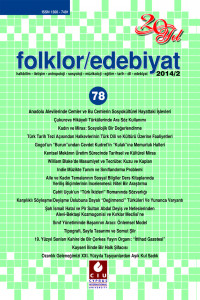Öz
Somut şiir, yazılı içeriği aktaran harflerin ve sözcüklerin, içerikle eşdeğer biçimde var
olduğu şiir türüdür. Metin sayfa üzerine aktarılırken, aktarım biçimi ve seçenekleri de anlamı
çeşitlendirir. Dili sayfa üzerinde görünür kılan tipografi, harflerin, sözcüklerin, boşlukların
sayfa üzerinde düzenlemesini yapar, yazıyı sayfaya taşır. Geleneksel şiir düzenlemelerindeki
sayfa tasarımı ve tipografi alışılagelmiş, okunurluk odaklı ve “sessiz” iken, somut şiirde aktiftir ve kimi zaman baskındır. İçeriğin biçimle birlikte var olduğu, şiirsel dilin grafik dille
birleştiği ve anlamların harmanlanarak yeni anlamlar ortaya koyduğu bu tür, yeni ürünler
vermeye potansiyeli olan disiplinlerötesi bir alandır.
1900’lerden itibaren yaygınlaşan, özellikle Futurizm ve Dada gibi sanat akımlarında en
uç örneklerinin görüldüğü somut şiir, edebiyat ve şiir için olduğu kadar, grafik tasarım ve
tipografi için de çarpıcı örneklerin olduğu bir türdür. Tipo baskı ve dizginin doğasında var
olan, doğrusallığı dikte eden yapıyı kıran şair ve tipograflar, yazı sanatına ve şiir sanatına
yepyeni bakışlar sunmuşlardır. Günümüzde artık neredeyse kullanılmayan tipo baskı ve
metal hurufatlar, yerini bu yapıyı taklit eden “sanal” sayfalara, klavye ve fareye bırakmıştır.
Gelişen masaüstü yayıncılık teknolojileriyle yaygınlaşan kelime işlem yazılımları yazıyı daha
da kolay işlenebilir hale getirmiştir. Somut şiire, bilgisayar teknolojilerinin hızla geliştiği
dönemde yeniden bir bakış, kelime işlem ve sayfa düzeni yazılımlarının da dayattığı “sanal”
doğrusallığın kırılması adına önem taşır.
Anahtar Kelimeler
Grafik Tasarım Görsel Şiir Sayfa Tasarımı Somut Şiir Tipograf
Kaynakça
- Alpaslan, G. G. (2005). Türk Edebiyatında Somut (Görsel) Şiir. Türkbilig: Türkoloji Araş- tırmaları Dergisi (10), 3-16.
- Becer, E. (2007). Modern Sanat ve Yeni Tipografi. Ankara: Dost Kitabevi Yayınları.
- Carter, R., Day, B., & Meggs, P. (2002). Typographic Design: Form and Communication. New Jersey: John Wiley & Sons, Inc.
- Lupton, E. (2010). Thinking With Type. New York: Princeton Architectural Press.
- Middentorp, J. (2012). Shaping Text. Amsterdam: BIS Publishers.
- Smith, K. A. (1997). Text in the Book Format. Rochester: Keith a smith BOOKS.
- Solt, M. E. (1968). Concrete Poetry: A World View. Erişim 21.12.2013, UBU: http://www. ubu.com/papers/solt/index.html
Öz
Concrete poetry is a genre in which words and letters that transmit the written content
have equal presence as the content itself. When a text is transmitted onto a page, the way it
is transmitted change and diversify its meaning. Typography, which makes language visible
on page, makes arrangements of letters, words, spaces on a page; it transfers text to page.
Page layout and typography on conventional poetry looks ordinary, focuses on reading and is
“silent”, while in concrete poetry it is active —and in some cases, dominant. Concrete poetry
is a transdisciplinary genre that has a potential to give birth to new products in which content
comes into existence together with form, poetic language collide with graphic language and
meanings are collated to create new.
Concrete poetry became popular after 1900’s and the strongest examples were seen
as part of Futurism and Dada art movements; it is a genre that produced works that are
as significant to literature and poetry as to graphic design and typography. The poets and
typographers who broke the linearity in the very nature of letterpress and typesetting have
given a new perspective to the art of type and poetry. Today, the metal type and letter press
technology left its place to “virtual” pages, keyboard and mouse which mimic that technology.
The emerging desktop publishing technologies and widespread of word processing software,
made it possible to work with type. It is significant to take another look at concrete poetry
at this age of fast developing computer technologies to break the “virtual” linearity that is
forced by word processor software and page layout.
Anahtar Kelimeler
Concrete Poetry Graphic Design Page Layout Typography Visual Poetry
Kaynakça
- Alpaslan, G. G. (2005). Türk Edebiyatında Somut (Görsel) Şiir. Türkbilig: Türkoloji Araş- tırmaları Dergisi (10), 3-16.
- Becer, E. (2007). Modern Sanat ve Yeni Tipografi. Ankara: Dost Kitabevi Yayınları.
- Carter, R., Day, B., & Meggs, P. (2002). Typographic Design: Form and Communication. New Jersey: John Wiley & Sons, Inc.
- Lupton, E. (2010). Thinking With Type. New York: Princeton Architectural Press.
- Middentorp, J. (2012). Shaping Text. Amsterdam: BIS Publishers.
- Smith, K. A. (1997). Text in the Book Format. Rochester: Keith a smith BOOKS.
- Solt, M. E. (1968). Concrete Poetry: A World View. Erişim 21.12.2013, UBU: http://www. ubu.com/papers/solt/index.html
Ayrıntılar
| Diğer ID | JA67HE38DN |
|---|---|
| Bölüm | Araştırma Makaleleri - Research Articles |
| Yazarlar | |
| Yayımlanma Tarihi | 1 Ağustos 2014 |
| Yayımlandığı Sayı | Yıl 2014 Cilt: 20 Sayı: 78 |
Derginin yayım dili Türkçe ve İngilizce’dir, ayrıca Türkçe de olsa tüm basılan makalelerin başlık, öz ve anahtar sözcükleri İngilizce olarak da makalede bulunur. Hakemlerden onay almış Türkçe makaleler için 750-1000 sözcükten oluşan genişletilmiş özet (extended summary) gereklidir. Elektronik çeviriler kabul edilmez.
Dergi TR-Dizin, Web of Science (ESCI), DOAJ ile diğer pek çok dizin tarafından taranmaktadır. Scimagoe quartile değeri: Q2 'dir:
TR DIZIN 2020 Etik Kriterleri kapsamında, dergimize 2020 yılından itibaren etik kurul izni gerektiren çalışmalar için makalenin yöntem bölümünde ilgili Etik Kurul Onayı ile ilgili bilgilere (kurul-tarih-sayı) yer verilmesi gerekecektir. Bu nedenle dergimize makale gönderecek olan yazarlarımızın ilgili kriteri göz önünde bulundurarak makalelerini düzenlemeleri önemle rica olunur.
Alan Editörleri/ Field Editörs
Halkbilimi/Folklore
Prof.Dr. Hande Birkalan-Gedik (JohannWolfgang-Goethe İniversitet-birkalan-gedik@m.uni-frankfurt.de)
Prof.Dr. Ali Yakıcı (Gazi Üniversitesi-yakici@gazi.edu.tr)
Prof.Dr. Aynur Koçak (Yıldız Teknik Üniversitesi-nurkocak@yildiz.edu.tr)
Prof.Dr. Işıl Altun ( (Regensburg Üniversitesi/Kocaeli Üniversitesi-İsil.Altun@zsk.uni-regensburg.de)
Edebiyat/Literature
Prof.Dr. Abdullah Uçman (Mimar Sinan Güzel Sanatlar Üniversitesi -emekli-29 MayısÜniversitesi-abdullahucman@29mayis.edu.tr
Prof. Dr. Ramazan Korkmaz (Ardahan Üniversitesi-emekli-Kafkasya Üniversiteler Birliği -KÜNİB-r_korkmaz@hotmail.com)
Prof.Dr. Emel Kefeli (Marmara Üniversitesi-emekli-İstanbul 29 Mayıs Üniversitesi-ayseemelkefeli @gmail.com)
Prof.Dr. Zekiye Antakyalıoğlu ( İstanbul Aydın Üniversitesi-zekabe@hotmail.com)
Antropoloji/Anthropology
Prof.Dr. Hanife Aliefendioğlu (Doğu Akdeniz Üniversitesi-hanife.aliefendioglu@emu.edu.tr)
Prof. Dr. Şebnem Pala Güzel (Başkent Üniversitesi-sebnempa@baskent.edu.tr)
Prof.Dr. Derya Atamtürk Duyar (İstanbul Üniversitesi-datamturk@istanbul.edu.tr)
Prof.Dr. Meryem Bulut (Ankara Üniversitesi-meryem.bulut@gmail.com)
Dil-Dilbilim/Language-Linguistics
Prof.Dr. Nurettin Demir (Hacettepe Üniversitesi-demir@hacettepe.edu.tr)
Prof. Dr. Aysu Erden (Maltepe Üniversitesi-aysuerden777@gmail.com)
Prof.Dr. Sema Aslan Demir (Hacettepe Üniversitesi-semaaslan@hacettepe.edu.tr)


